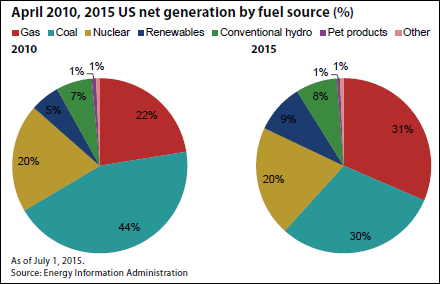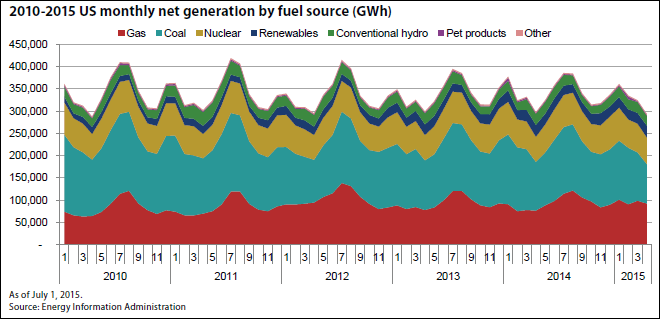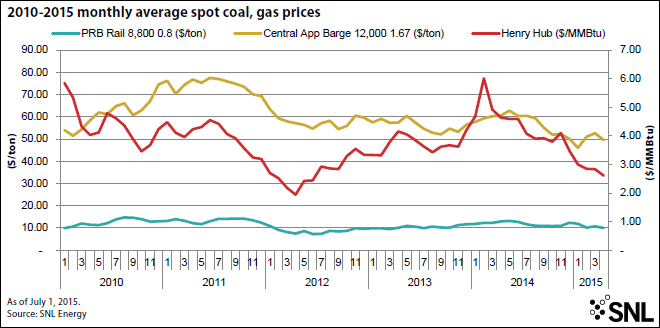"The war on coal" might have just witnessed another battle in April as the latest " Electric Power Monthly" data from the U.S. Energy Information Administration show total natural gas-fired electric generation in April surpassed coal-fired power generation for the first time in history.
Electric Power Monthly" data from the U.S. Energy Information Administration show total natural gas-fired electric generation in April surpassed coal-fired power generation for the first time in history.
The June 25 report from the EIA showed 92,516 GWh was produced in April using gas compared to 88,835 GWh produced using coal. This means that natural gas drove 31% of all electric-power generation in April, up from 22% in April 2010. At the same time, the share of power coming from coal has fallen from 44% in April 2010 to 30% this past April.

While this is the least amount of monthly electricity produced by coal in more than a decade, it is by no means the most power produced using gas. In 2012, another low-price year for natural gas, 138,863 GWh was produced in July and 131,736 GWh was produced in August.

To some degree, the latest statistics reflect the low-demand season with both fuels showing a big drop from the winter months. April's power production from gas was down almost 9% from the 101,330 GWh produced from gas in January while coal's power output in April was down more than 33% from the 132,742 GWh produced from coal in January.
New environmental regulations and low gas prices are other key factors leading to the shift to natural gas for power generation.
While the U.S. Supreme Court on June 29  remanded the EPA's Mercury and Air Toxics Standards, or MATS, rule back to the U.S. District Court for the District of Columbia for reconsideration, the industry has already seen a large wave of coal plant retirements ahead of the MATS effective date on April 15.
remanded the EPA's Mercury and Air Toxics Standards, or MATS, rule back to the U.S. District Court for the District of Columbia for reconsideration, the industry has already seen a large wave of coal plant retirements ahead of the MATS effective date on April 15.
In a May 14 " Today in Energy" report, the EIA said that in addition to 4.1 GW of coal capacity that was retired last year, plant operators have retired or plan to retire 12.8 GW of coal capacity in 2015. However these retiring coal plants are generally smaller units that have typically operated at lower capacity factors in recent years. The coal capacity retiring in 2015 accounted for 1.6% of total U.S. generation during 2014, the agency said.
Today in Energy" report, the EIA said that in addition to 4.1 GW of coal capacity that was retired last year, plant operators have retired or plan to retire 12.8 GW of coal capacity in 2015. However these retiring coal plants are generally smaller units that have typically operated at lower capacity factors in recent years. The coal capacity retiring in 2015 accounted for 1.6% of total U.S. generation during 2014, the agency said.
Most of this retired generation was replaced with gas-fired capacity, due largely to the low cost of gas. While Central Appalachian coal prices have fallen in recent years, natural gas has been at an economic advantage for much of 2014 and has seen that advantage grow so far in 2015.

The convergence of the two fuels as a source for power generation was  not a big surprise. The two fuels
not a big surprise. The two fuels  approached parity in April 2012, as Henry Hub natural gas prices slumped to a 10-year low below $2/MMBtu. By comparison, natural gas futures prices slumped below $2.50/MMBtu for a few days in April and have been holding near $2.80/MMBtu in recent weeks.
approached parity in April 2012, as Henry Hub natural gas prices slumped to a 10-year low below $2/MMBtu. By comparison, natural gas futures prices slumped below $2.50/MMBtu for a few days in April and have been holding near $2.80/MMBtu in recent weeks.
"Natural gas-fired generation has been rising over the past few months, as the cost of natural gas has fallen to levels not seen since 2012," the EIA said in the May 14 report. "These low fuel costs have made natural gas combined-cycle generating units in some areas of the country cheaper to operate than coal-fired plants. The increase in natural gas-fired generation has largely come at the expense of coal generation. Generation from both fuels generally falls during the spring months as power plant operators take units offline for maintenance when electricity demand is relatively low."
The agency said that power generation from the two fuels over the next couple months is expected to rise at rates similar to 2012 and then diverge again later in the summer as demand rises and coal unit capacity utilization continues to rise.
"Rising natural gas costs and the return of coal plants after spring maintenance will likely increase the level of coal generation," the agency said.
Overall, the EIA said in its latest  Short-Term Energy Outlook that it expects coal's share of U.S. total generation will average 35.6% in 2015, down from 38.7% in 2014. In contrast, the natural gas fuel share averages 30.9% this year, up from 27.4% in 2014.
Short-Term Energy Outlook that it expects coal's share of U.S. total generation will average 35.6% in 2015, down from 38.7% in 2014. In contrast, the natural gas fuel share averages 30.9% this year, up from 27.4% in 2014.
To find details on active U.S. and Canadian power plants, go to SNL Energy's Power Plant Briefing Book Search. To view a wide range of data for NERC, NERC subregions, planning areas or balancing authorities, go to SNL Energy's Regional Power Markets Summaries. For more detailed market data, including SNL power, natural gas and coal index prices, as well as forwards and futures, visit SNL Energy's Commodities Pages.


